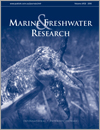Marine and Freshwater Research
Volume 69
Number 3 2018
The study investigated the effect of Murray River outflows on the coastal ocean productivity beyond the Murray Mouth. Using historical flow records and satellite-imagery products, our findings suggested that declining river flows have greatly reduced coastal ocean primary productivity. There are likely to be negative consequences of this on coastal ecosystems and fisheries, and the effects of outflows warrant improved consideration in river-management plans.
Experiments were conducted to evaluate the effects of abiotic variables on phytoplankton in tropical and semi-arid climates. Climate was found to determine the effects of abiotic variables on the phytoplankton community in both an independent and synergistic manner. Phytoplankton in tropical and semi-arid reservoirs are mostly regulated by nutrients, the effects of which vary according to climate.
Historical and contemporary levels of white shark bycatch are unknown. Based on interviews with commercial fishers, the catch of white sharks off Western Australia was reconstructed, with the results suggesting that the catch peaked in the late 1980s. Fishers expressed doubts about the accuracy of self-reported white shark catch data, a requirement of current legislation. Efforts to accurately record this information should be improved.
This study compared recent and historic longline catch rates to determine whether juvenile school shark (Galeorhinus galeus) continue to use nursery areas closed to fishing in south-eastern Australia, following overfishing during the 1940s and 1950s. Our data suggest that abundances in the nursery areas may have increased, or at least remained stable, since the 1990s, which may be indicative of some stock recovery.
The sea mullet Mugil cephalus is a commercially important species globally and within Australia. The eastern Australian stock of sea mullet has a long history of heavy exploitation during its annual northerly spawning migration, yet the fishery is sustainable. Here we propose a model whereby sex-specific differences in life history and biological parameters contribute to population resilience and so support a sustainable commercial fishery.
Biodiversity is a multifaceted concept. Patterns of the taxonomic, functional and phylogenetic diversity of fish were studied across a depth gradient from 3 to 31 m. The results demonstrated decays in biodiversity, from different perspectives, of reef fish with depth, which are connected with shifts in fish traits, in particular their shape and trophic mode.
The reproductive characteristics of three commercially important small-bodied cuttlefish (Sepia opipara, S. plangon and S. rozella) from subtropical Australia are described for the first time. All species showed year-round spawning, but differed in seasonality, reproductive mode, size at sexual maturity, mature oocyte and spermatophore sizes and potential fecundity. The findings of this study highlight the variable nature of cuttlefish life histories and the need for species-specific information for fisheries and conservation management.
Using a two-step statistically based, hierarchical, multiscaled approach to the floristic classification of ephemeral wetlands within western New South Wales, Australia, we define three ecoregions and 18 vegetation groups. Our approach shows that a consistent objective classification can be derived for vegetation systems with good data within regions that are otherwise poorly sampled.
Dissolved oxygen depletion is a rising concern in global aquatic ecosystems. In this study we used high-resolution, multiyear observations of a coastal environment to show prolonged periods of anoxia, with rare re-oxygenation events being caused by unusual combinations of climatic and oceanographic conditions. These findings highlight that dissolved oxygen dynamics in coastal habitats may be modified by climate-driven environmental change.
How many hatchery fish survive after release? In outdoor predation experiments using camera trapping, we found that the size of fish at release and the predators’ feeding style and behaviour had significant effects on the survival of fish. The results indicate the importance of not only optimising the size of released fish, but also understanding the local predators for successful fish stocking.
The ontogenetic performance of DNA and RNA content and the nutritional condition of Prochilodus lineatus were studied in larvae reared under different feeding treatments. The availability of food following a period of starvation seemed to trigger larval metabolism and cellular division. The ratio of RNA/DNA promptly reflected changes in larval feeding conditions and could be used to assess the nutritional condition of both wild and cultured P. lineatus larvae.
Stable isotopes (δ13C and δ15N) have been widely used to investigate marine-predator movement and foraging ecology. In the present study, intra-regional range of isotope values indicated that squid off Ecuador feed at the same trophic level with similar primary production, whereas squid off Chile, especially Peru, migrate over a large geographic range and occupy a wide range of trophic levels.
This paper provides a description and evaluation of a retrieval pod that can be attached to remote release underwater telemetric or oceanographic devices to facilitate the retrieval of moorings. The system was successfully tested in an estuary after consecutive 6-month deployments. The pods are a convenient and low-cost option for the retrieval of moorings deployed with remote release systems.
This study provides insights into nekton communities as possible indicators of habitat functionality in planted mangroves. The community structure of nekton was compared between planted and natural mangrove stands (as a reference trajectory). Nekton assemblage in general (especially fish species) is not a reliable restoration indicator because it is not entirely dependent on mangroves. Crustaceans demonstrated more dependency on habitat structural complexity and food offered by mangroves.




